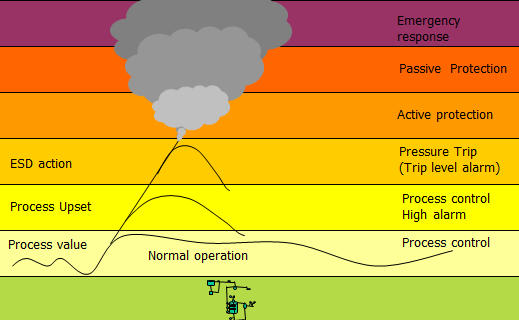SIL Assessment (with LOPA Methodology) Training for Engineers

About Course
The need for functional safety expertise is ever increasing and a growing challenge in the hydrocarbon, petrochemicals and chemicals industry across the globe. The energy demands over the past decade, especially in the Emerging Economies, have seen an exponential growth in the hydrocarbon and allied sectors. This has resulted in incidents related Process Safety such as explosions and release of toxic gases resulting in fatalities and injuries.
USPEnergies is an organization with expertise in the domain of functional Safety. USPEnergies is now offering training program focusing on SIL assessment with LOPA Methodology.
LOPA is an acronym for Layers Of Protection Analysis. The method starts with data developed in the Hazard and Operability study (HAZOP) and considers each identified hazard by documenting the initiating cause or causes and the corresponding protection layers that prevent or mitigate the hazard. The total risk reduction can then be determined; the need for further risk reduction can be analyzed based on the corporate risk tolerance criteria. If additional risk reduction is required and if it is to be provided in the form of a Safety Instrumented Function (SIF), LOPA methodology allows the determination of the appropriate Safety Integrity Level (SIL) for the SIF. The safety lifecycle defined in IEC 61511-1 requires the determination of a safety integrity level for the design of a safety-instrumented function.
LOPA training is provided by an expert trainer, Umesh Goel with over thirty years of experience industry, utilizing a practical and interactive approach. The session includes several work-shops and mock LOPA studies, thus giving the candidates invaluable hands-on-experience.
What Will You Learn?
- Effectively participate and understand the SIL Assessment with LOPA methodology
Course Content
LOPA Basics
This lesson covers the fundamentals of Layer of Protection Analysis
-
LOPA Basics
02:10 -
The Concept of Residual Risk
00:00 -
The Concept of PFD (Probability of Failure on Demand)
00:00 -
Quiz-1: LOPA Basics
LOPA Details
This lesson covers additional details about Layer of Protection Analysis
-
When to carry out LOPA, who will carry out LOPA and Data required?
00:00 -
Steps for LOPA Study
00:00 -
LOPA Advantage/Weaknesses
00:00
Impact Event
This lesson covers the Impact Event (Risk Tolerance Criterion / Target Event Frequency) and Conditional Modifiers in detail
-
Impact Event (Consequence identified in HAZOP)
-
Conditional Modifiers
-
Target Event Frequency (TEF)
-
Quiz-2: Impact Event
Initiating Event
This lesson covers the Initiating Events / Initiating Causes, Frequencies and Enabling Conditions in detail
-
Initiating Events / Initiating Causes
-
Enabling Events / Conditions
-
Failure Rate data
-
Quiz-3: Initiating Event
Protection Layers
This lesson covers Protection Layers / Safeguards / Barriers in detail
-
Protection Layers
-
Protection Layers and ‘Onion Ring’ concept
00:00 -
The ‘Independence’ of Protection Layer
-
Quiz-4: Protection Layers
SIL Basics
This lesson covers the fundamentals of SIL Classification/Assessment
-
SIL Basics
-
Typical SIF
-
SIF Advantages / Weaknesses
-
Quiz-5: SIL
Focus on SIFs
This lesson covers the SIFs (Safety Instrumented Functions) and their redundancy, reliability and fault tolerance in detail
-
Target SIL vs Achieved SIL
-
SIF Component Redundancy
00:00 -
SIL of individual components
00:00 -
Quiz 6: SIF
LOPA Workshop-1
This workshop covers the residual risk / PFD calculations for a Hazard scenario (Overpressurization of Feed Surge Drum)
-
Hazard Scenario Description
-
LOPA Input Data – Target Event Frequencies/Failure Rates
-
LOPA / SIL PFD calculations
-
Quiz-Workshop-1
LOPA Workshop-2
This workshop covers the residual risk / PFD calculations for a Hazard scenario (Loss of level in Feed Surge Drum V-101)
-
Hazard Scenario Description
-
LOPA Input Data – Target Event Frequencies / Failure Rates
-
LOPA / SIL PFD calculations
-
Quiz-LOPA workshop-2
Student Ratings & Reviews

